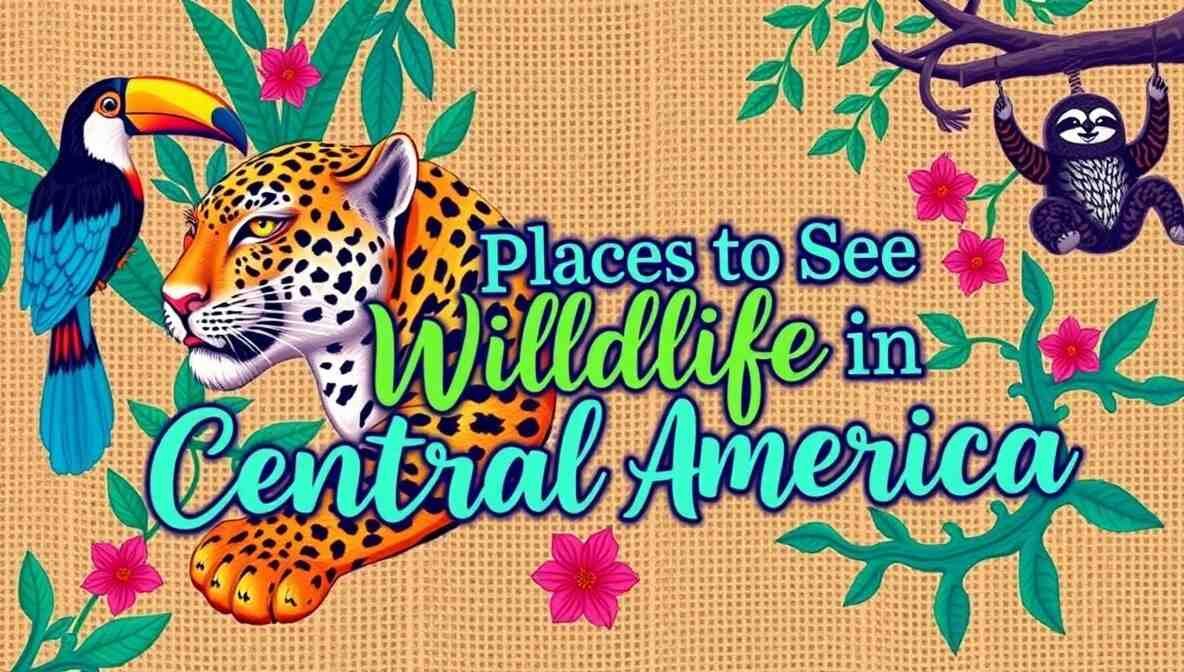Central America is a wildlife watcher’s paradise. This lush region, sandwiched between two oceans, is brimming with biodiversity and natural beauty. From the rainforests of Costa Rica to the coral reefs of Belize, Central America captivates every visitor with its rich ecosystems and exotic creatures. Home to jaguars, toucans, sea turtles, and colorful frogs, this part of the world is unmatched in its variety of flora and fauna.
If you’re a nature lover or adventurer seeking incredible encounters, Central America is undeniably one of the best places to see wildlife in Central America.

Why Central America Is the Best Place to See Wildlife
Central America’s unique position between North and South America makes it a biological hotspot. Migrating birds, rare mammals, and an abundance of marine life thrive within its dense forests, sprawling wetlands, and coastal waters. The region contains several UNESCO World Heritage Sites and biosphere reserves meticulously maintained to protect endangered species and habitats.
Countries like Costa Rica and Panama lead conservation efforts by setting aside vast tracts of land as protected areas. From the Monteverde Cloud Forest Reserve to the Banana River Estuary, the commitment to preservation ensures future generations can enjoy these natural wonders.
Central America’s blending of oceanic and rainforest habitats creates a rare dynamic where coral reefs meet jungles, offering an unparalleled wildlife experience.
Top Wildlife Spots in Central America
1. Monteverde Cloud Forest Reserve, Costa Rica
Known for its mysterious misty atmosphere, Monteverde is home to rare creatures like the resplendent quetzal, three-wattled bellbirds, and howler monkeys. The dense cloud forest creates a magical backdrop teeming with hidden wildlife and vibrant plants.
2. Corcovado National Park, Costa Rica
Located on the Osa Peninsula, this park is among the most biologically intense places in the world. Visitors can spot jaguars, scarlet macaws, and tapirs roaming through its tropical rainforests.
3. Cockscomb Basin Wildlife Sanctuary, Belize
Famed for its jaguar preserve, this sanctuary also houses butterflies, ocelots, and howler monkeys. Its trails are perfect for nature hikes leading to stunning waterfalls and wildlife-rich forests.
4. Tikal National Park, Guatemala
Aside from its breathtaking Mayan ruins, Tikal is a hub for wildlife including toucans, monkeys, and countless bird species. The sound of howler monkeys echoing across the ancient temples adds to the allure.
5. Roatán, Honduras
This island is ideal for marine wildlife lovers. Its vibrant coral reefs house whale sharks, sea turtles, and colorful tropical fish. Dolphins are also frequently spotted during boat tours.
Best Time of Year to Spot Wildlife in Central America
Wildlife watching in Central America is spectacular year-round but varies depending on the season and the species you want to see.
- Dry Season (December–April): Best for exploring national parks and forests, as animals like monkeys, sloths, and toucans are out in abundance.
- Green Season (May–November): Watch nesting sea turtles along Pacific beaches and enjoy vibrant rainforest blooms. Migrating birds also visit during this period.
- Marine Wildlife Timing: February to April offers opportunities to see whale sharks, while humpback whales are commonly seen from December to March.
Research the species you’re most interested in to align your visit perfectly with their active seasons.
Animals You Can Expect to See in Central America
Central America’s biodiversity makes it one-of-a-kind. Here are some species you can expect to encounter:
- Mammals: Jaguars, sloths, anteaters, Baird’s tapirs, and howler monkeys.
- Birds: Resplendent quetzals, scarlet macaws, toucans, and king vultures.
- Marine Life: Whale sharks, sea turtles (green and leatherback), and parrotfish.
- Reptiles & Amphibians: Dart frogs, iguanas, and crocodiles.
- Butterflies & Bugs: The iconic Blue Morpho butterfly and other dazzling insects.
With such diversity, spotting wildlife in Central America feels like stepping into a nature documentary.
Tips for Safe & Ethical Wildlife Viewing
Enjoy wildlife responsibly with these actionable tips:
- Keep a Respectful Distance: Use binoculars to observe animals up close without intruding on their space.
- Avoid Flash Photography: Sudden bright lights can stress creatures, so opt for natural light or low-level lighting.
- Stick to Trails: Preserve fragile ecosystems by only walking on designated paths.
- Support Sustainable Tours: Choose eco-certified guides who follow ethical wildlife viewing practices.
- Don’t Feed Wildlife: Feeding animals alters their natural behavior and may cause harm to both them and you.
Wildlife Photography Tips
Capture stunning moments while staying respectful to nature with these tips:
- Use Telephoto Lenses: A lens in the 300mm range lets you capture detailed shots without disturbing the animals.
- Golden Hours Magic: Shoot during sunrise or sunset for softer light and more active wildlife.
- Choose Silent Modes: Avoid startling animals by shooting with reduced shutter noise.
- Bring Weather Gear: Tropical climates can bring sudden rain, so keep your camera equipment protected.
- Compose With Habitat: Enhance photos by including elements of the environment to show the animals in their natural context.
How to Get to Central America’s Top Wildlife Destinations
Traveling to Central America is fairly accessible. Here’s how to get started:
- By Air: Major hubs include Costa Rica’s Juan Santamaría International Airport (SJO), Guatemala City’s La Aurora Airport (GUA), and Panama City’s Tocumen Airport (PTY).
- By Boat: Roatán and neighboring islands are reachable by ferry or cruise liners.
- Guided Tours: Book eco-tours to access remote trails and areas reserved for protected wildlife.
Affiliate Suggestion:
Reserve eco-friendly tour packages here [#] to simplify logistics while leaving a lighter footprint.
Where to Stay Nearby
Here are excellent lodging options near Central America’s wildlife hotspots:
- Budget: Selina La Fortuna, Costa Rica – Affordable accommodations surrounded by tropical charm.
- Mid-Range: Cockscomb Basin Cabins, Belize – Comfortable lodgings close to jaguar territory.
- Luxury: Lapa Rios Lodge, Costa Rica – A sustainable retreat on the Osa Peninsula for nature lovers.
Affiliate Suggestion:
Unlock exclusive discounts at these lodges [#] and upgrade your wildlife experience.
Nearby Attractions or Activities
Enhance your trip with more unique experiences in Central America:
- Mayan Temples of Tikal: Pair your wildlife exploration with rich history and iconic ruins.
- Lake Atitlán, Guatemala: Combine birdwatching with dramatic volcanic scenery.
- Belize Barrier Reef: Snorkel or scuba on the world’s second-largest coral reef.
Conclusion
Central America stands out as one of the best places to see wildlife thanks to its breathtaking landscapes, commitment to preservation, and astonishing diversity of species. Each visit unveils the vibrant heartbeat of nature through encounters with toucans, sloths, jaguars, and marine wonders.
It’s time to plan your adventure. Discover Central America’s wildlife gems and create memories that will last a lifetime.
FAQs
- What is the best country in Central America for wildlife?
Costa Rica is often hailed as the best due to its extensive national parks and biodiversity richness. - When is the best time to see sea turtles in Central America?
Sea turtles nest on Pacific beaches between July and November, with October being a peak month. - Can I see jaguars in the wild?
Sightings are rare but possible in places like Corcovado National Park and Belize’s Cockscomb Basin. - What safety precautions should I take?
Stick with experienced guides, stay hydrated, and avoid touching or feeding wildlife. - Do I need special permits for wildlife photography?
Generally, no, but some protected areas charge fees for professional photography. Check ahead.

Anamika is a passionate writer for Eco365Store.com, specializing in topics that inspire a cleaner, greener world. With expertise in home cleaning, recycling, and eco-friendly solutions, she crafts engaging and informative articles that help readers adopt sustainable practices in their daily lives.

